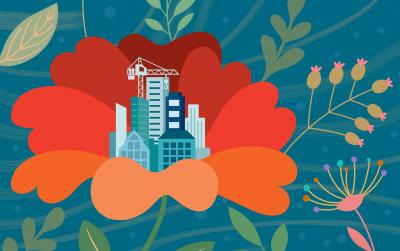From the Editors: To Bloom or Not to Bloom?
April 7, 2021
Is it finally safe to open up yet?
Flowering plants carefully consider this question each spring, taking cues from sunlight, moisture levels, and temperature before one gene — APETALA1 (AP1) ultimately makes the call. AP1 gives the plant's meristems (active growth regions at the tips of roots and shoots) the all-clear to leave leaf production behind and go full "petal" to the metal. It's a delicate decision — bloom too soon and they might get frozen out or snowed on; bloom too late and they could miss out on attracting pollinators ever-eager to help their species proliferate.
To prevent this, plants have numerous failsafes in place. They possess photoreceptors for sensing both red and blue light, feeding them information about the current time of year and length of day. They pack thermoreceptors for reading both air and soil temperature, because ground temps provide better grounds for prudent decision-making by virtue of their more gradual rates of change.
For many species, the cooldowns are as important as the warmups. The majority of perennials grown in temperate climates are actually hardcoded for dormancy — they're evolutionarily required to chill before flowering even becomes a possibility. This process, vernalization, often coincides with the Vernal Equinox — aka spring (aka atmospheric potluck, aka "What even is this right now?") Of course, in the event of an especially mild winter, vernalization may never happen at all.
All of this is to say that AP1, the blossoming gene-in-chief, is saddled with a lot of liability come springtime. Our government and business leaders can certainly empathize with its dilemma. At one or more junctures during this pandemic, they've also asked themselves "How soon is too soon?" and "How late is too late?" as they've weighed safety against economic survival. For a city like Erie that had just begun to bloom into a new season of progress, COVID-19 was the proverbial spring snowstorm.
Although some businesses have tragically and inevitably wilted away, we're by and large a hearty lot. Industry, innovation, and entrepreneurship endure despite the current challenges and the obstacles ahead. A cross-pollination of ideas and resources continues between startups and incubators. The 2020 economic deep freeze was damaging to most, lethal or near-lethal to some, and unpleasant to nearly all. But there is a fairly consistent refrain echoing throughout these pages — from business owners both young and old, both new and established, community stakeholders large and small — we just may be better for it.
Even as it does become safer to open up, the long-range economic forecast is still a bit hard to gauge. However, we have reason to hope that Erie is a perennial that's vernalized.




